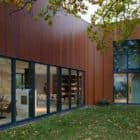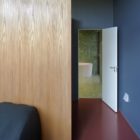Claesson Koivisto Rune Architects created this contemporary residence for a client living in Edsviken, Sweden.
The 2013 project features a unique curved L-shape that conforms to the site while allowing a smooth spatial flow from one end of the house to the other.
Fagerström House by Claesson Koivisto Rune Architects:
“The client had split his garden city plot in two and moved the old house to the one. The other had a more embedded position, including a big old oak tree in the middle.
The gross building allowance had to be fully exploited in order to create a large enough home for the growing family. The stipulated distance to the property line of course limited the positioning from the sides, while the desire to preserve the old oak tree blocked the middle.
The curved L-shape stems completely out of the zoning regulations. The actual bend gives the house an interior spatial flow that would have been broken if we’d chosen a sharp corner. The curving of course also makes for an iconic and sculptural exterior – something that the client specifically requested.
Another distinctive feature is the facade colour. Vertical boards are painted in different Falun red shades. An irregular transition from ocher (wide boards) to dark red (narrow boards) happens from the bedroom end to the living room end. The inspiration for the colour mixture was taken from the Swedish children’s book ‘Where’s the Tall Uncle’s Hat? ‘.
The house has two floors in its tall end. That’s where you find bedrooms etcetera. In the second lower end, the upper floor terminates with a balcony facing the interior living room with its high ceilings. The roof has a diagonal, pitch; from one end to the other and also backwards. This skews the house’s gables but also makes for the constant changing of room geometry as one moves through the house.
The house’s waistline houses the kitchen and, behind a bookcase, stairs. The kitchen thus is very much open while the stairs up to the more private spaces are more to the side. With its slow climb, the stairs gives a you a feeling of ‘proceeding’ rather than walking between levels.
All openings / glazing is carefully placed so that visibility from neighbours is avoided. This also creates a feeling that the house is located in a place far more sparsely populated than the area in reality is. As if it was just the house and the outdoors.
Instead of a larger number of conventional windows, the remaining placements are generously glazed. For example, the living room is completely glazed toward a conservatory. As an outside extension of the living room.
The entrance floor is made of Carrara marble. The tiles are laid perpendicular to the main facade, even where the room bends (like a fan). An integrated blood-red bookcase and staircase flows into an equally blood-red wood floor upstairs. The bathrooms are tiled (floor, walls and ceiling) with different patterns from Marrakech Design’s collection by Claesson Koivisto Rune.
We thought of the house as if it designed itself; that it was neither particularly strange or extreme. But everyone else evidently did not agree. When the house was finished or nearly finished three cars drove into the concrete blocks placed on the street right outside to prevent high speed in the area. Three drivers, three different occasions, who could not keep their eyes on the road.”

Photos by: Åke E:son Lindman















































The interior is stunningly beautiful! Great design.